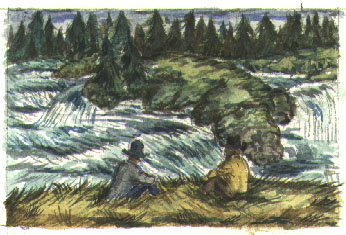|
J. William T. "Bill" Youngs, The Fair and the Falls: Spokane’s Expo ’74: Transforming an American Environment, Chapter One
|
"James Glover" Courtesy of the Museum of Arts and Culture
|
Chapter I: James Glover: Purchasing the Falls |
SummaryChapter one tells the story of the James Glover's first encounter with Spokane Falls in 1873. At the time, only a few whites lived by the falls; Spokane was still Indian country. Arriving by horseback, Glover viewed an enchanted land, one of the most beautiful sites in the entire west. Soon to be known as "The Father of Spokane," James Glover hoped to tame the river and build a great city by the falls. But before he began the work of conquest, he paused and admired the scene.
|
Author Reads from the Text
"Gazing and Wondering"
On the morning of May 12, 1873, James Glover awoke on the dirt floor of a roofless log cabin where he had just spent his first night in Spokane. As he rolled out of his blankets, he told himself, "I am going to see the falls." He was soon sitting on "a great rock" overlooking the Spokane River. Remembering the moment many years later, Glover wrote: "I gave myself completely over to admiration and wonder at the beautiful, clear stream that was pouring into the kettle and over the falls." He was so engrossed that he let himself be soaked by the spray: "I sat there, unconscious of anything but the river, gazing and wondering and admiring."
"I was determined that I would possess it."
The river must have been magnificent that day. The spring run-off would have sent water surging past the rocks and islands. "I was enchanted-overwhelmed-with the beauty and grandeur of everything I saw," wrote Glover. "It lay just as nature had made it, with nothing to mar its virgin glory." While awestruck by the falls, Glover also experienced a different, but equally powerful sensation-acquisitiveness. Having seen the river's beauty, he made a fateful choice: "I determined that I would possess it."
"Possession" was the key word. Glover was possessed by the falls, and at the same time he was eager to possess them.
"Possession" was the key word. Glover was possessed by the falls, and at the same time he was eager to possess them.
James Glover in the West
View James Glover in the West in a larger map

